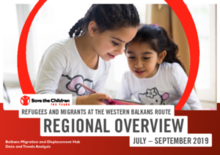Data and Trend Analysis (DATA) Refugees and Migrants at the Western Balkans Route Regional Overview, covering period July - September 2019, describes key trends in migrations in the region, detailing information about the number of people on the move, demography (age, sex, country of origin, etc), behavioral patterns, and routes in use - with a focus on children, particularly unaccompanied children.
Key trends showcased in this report:
- The Western Balkans Route remained the most traveled route to Europe during the third quarter of the year, with at least 27,800 newly registered migrants and refugees, a major increase when compared with the same period last year (16,000) or when compared with the previous quarter (10,600).
- More than 108,000 refugees and migrants were present in the Balkans at the end of Q3.
- The third quarter of 2019 also marked a change in demographics. Many more families, mostly from Syria and Iraq, and an increase in refugees and migrants from African countries were recorded.
- The percentage of unaccompanied and separated children (UASC) in the overall number of children varies from country to country, with most of them recorded in Serbia (65%)
- The vast majority of UASC in all the Balkans countries were boys from Afghanistan and Pakistan
Although the number of refugees and migrants trying to cross the Hungarian border remains high and attempts to cross from Serbia to Romania are increasing, the data shows that most refugees and migrants enter the Balkans through Greece and move towards Bosnia and Herzegovina.

